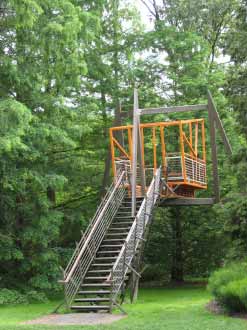
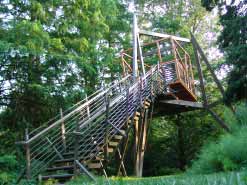
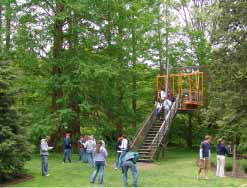
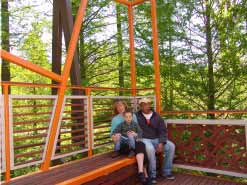
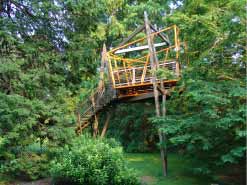
meta Metasequoia
In early 2003 when I was invited to curate an exhibition for Morris Arboretum, my thoughts turned to the artists John McQueen and Margo Mensing based on my knowledge of their past work. McQueen is well known for his work with natural materials, and Mensing delves into her projects by researching local history and science to create unique projects. They are both very imaginative and devote a great deal of attention to materials. McQueen has consistently worked with the same materials for years: sticks, twigs and bark, which he grows himself. Mensing’s materials range from needlework to glasswork to monumental mosaics made of punched out dots from security envelopes. They frequently collaborate to create witty site-integrated projects that relate to history, site, text and narrative. I knew they could design a work of art that would be engaging to all people, from the most sophisticated art viewer to young children.
When the artists first came to Morris Arboretum on a wintry day in November, 2003, their attention was immediately grabbed by the sculpture qualities of the Dawn Redwood (Metasequoia glyptostroboides), its unique history, and its ecological importance. Once thought to be extinct, these trees were found in China in the 1940s and have propagated throughout the world and particularly in Philadelphia. The grove at the Arboretum was planted in the early 1950s, and in this short time the trees have grown to over 90 feet tall.
The artists went back to their studios in upstate New York and developed a number of proposals. This is the most exciting part of the artistic process. Often many ideas develop until the best one emerges. They knew they wanted a piece that would involve the participation of the visitors to the arboretum; they like to engage by giving information, but not in a didactic way. They kept coming back to the Metasequoias. The ramp idea led to the notion of getting people up into the trees. They thought about fire towers, windmills, and tree houses. A “grasshopper” structure emerged – a long-legged structure that would bring the public up into the Metasequoias.
Concentrating on the “grasshopper” idea, Mensing and McQueen collaborated with Philadelphia architectural firm KSS Architects, and particularly J Shermeta. They designed meta Metasequoia, a viewing platform for visitors to climb twelve feet into the lower branches of the tree canopy, where they had an intimate, focused view of the tree, a place for quiet contemplation or reliving the childhood experience of climbing a tree.
In addition to the wonderful experience of climbing into the trees the artists included another component. meta meta is a narrative sound piece installed on the observation platform, offering visitors the opportunity to experience the trees on many levels. History and botanical insights relating to Metasequoia trees were told through a fanciful poetic dialogue between two characters, a Metasequoia tree and a person while a musical composition complemented the narrative. “I’m not quixotic, but I am exotic” and other witty phrases pepper the conversation while we learn a bit of the history of the life of the Metasequoia. We learned the multiple meanings of meta and about this unusual tree, which is both a conifer and deciduous.
Since its discovery, the Metaseqouia has been propagated around the world and today exists in plantations and as solitary trees growing in Asia, Europe, and North America. This hearty tree is resistant to disease and is a testament to the adaptable and tenacious quality of nature. Meta Metasequoia was designed to educate us about this magnificent and unusual tree, and to experience the joy of being up among its branches. I always learn new things from my projects.
